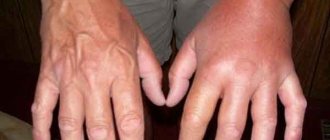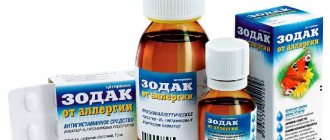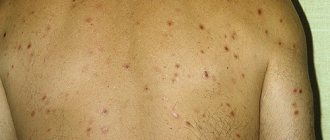Allergy to soy in infants, children, adults, symptoms, treatment
Products containing soy are taking up more and more space on store shelves.
Soy is introduced into semi-finished products in order to increase their nutritional value and to enrich food with the most essential microelements and minerals. But soy products cannot always be consumed, and the main reason is an allergic reaction to the plant. Soy allergy is common among adults and children; the symptoms of the disease are usually very pronounced, which leaves no doubt about the accuracy of the diagnosis.
Causes of soy allergy
Soybean is an annual plant belonging to the legume family. Its fruits contain a large amount of vegetable protein, which determines their nutritional value.
But on the other hand, it is these proteins, that is, soy protein, that are capable of triggering a specific immune reaction, leading to the development of an allergic reaction.
The predisposition to soybean intolerance is also inherited, that is, it can be a family disease.
When consuming soy products, it is worth taking into account the fact that the plant used as an additive is most often genetically modified.
And, as you know, genetically modified food components significantly disrupt the functioning of the immune system, which can provoke an allergic reaction.
When consuming natural soy, the intolerance reaction often occurs not to the plant itself, but to the toxic chemicals used in growing the crop.
Causes of soy intolerance in infants.
Soy is widely used in the food industry and baby food is no exception. This is why soy allergy is often detected in children at three to four months, that is, the cause of the disease is the consumption of a mixture or vegetable and fruit purees.
Allergies to legumes can also develop in babies who are fully breastfed.
In this case, the culprit of the intolerance reaction is the mother’s diet, which may also contain soy products.
Food allergies in infants occur due to:
- Increased permeability in the first year of life of the intestinal walls. This feature of the child’s body leads to the fact that allergens easily enter the bloodstream and cause allergic reactions.
- Insufficient amount of enzymes. Proteins that enter the digestive tract are not completely digested and become allergens.
However, most often, an allergy to soy in infants goes away with age and by about 5-6 years the body stops reacting with a specific reaction to soy protein.
Causes of soy intolerance in children.
Allergy to soy is most often registered in children 2-4 years old. In this age range, parents switch most babies to adult food, and naturally their diet expands - there are more products with soy.
The peculiarities of the legume family include the accumulation of vegetable protein in the body.
That is, the more soy products a child eats, the greater the load on the immune system, which may not cope with its work and react with allergies.
Products containing soy protein are not recommended to be given to children in large quantities. It is believed that they suspend physical development and disrupt the functioning of the immune system.
Therefore, soy milk, soy meat, cheeses with vegetable protein and even chocolate containing soy lecithin, designated as E322, should be included in the diet of children in very minimal quantities.
POPULAR WITH READERS: How does an allergy to meat manifest itself?
Causes of soy intolerance in adults.
If a food allergy to soy is first recorded in an adult, then in most cases it is provoked either by a modified composition of the product or by certain health problems.
POPULAR WITH READERS: Treatment of peanut allergies
This statement is due to the fact that soy protein is included in most of the most commonly used products and therefore, with a hereditary predisposition, an allergic reaction would have occurred in childhood.
An allergic reaction to soy often occurs in an adult in the following situations:
- In the chronic course of various digestive pathologies, waste. Impaired functioning of the digestive organs affects the poor digestibility of food and leads to atypical metabolic reactions.
- With a pronounced decrease in the immune system. When the immune system does not work as it should, many proteins that come with food are regarded as allergens.
Therefore, if intolerance to soy products occurs in adulthood, then it is necessary to determine whether there are pathological changes in the body’s internal organs.
WORTH KNOWING: Is it possible to be allergic to garlic?
Diagnosis and symptoms of the disease
The doctor is responsible for identifying the cause of the allergic reaction and treating it.
To establish a diagnosis, a blood test is prescribed to determine the level of immunoglobulin E and skin patch tests showing the specific type of allergen.
And only after determining the cause of the disease, the doctor selects a comprehensive treatment.
Symptoms of intolerance to soy products are of no small importance when assessing the patient’s condition.
Allergy to soy in most established cases manifests itself:
- Rashes on the skin. More often the rash is pinpoint, localized on the abdomen, arms, and neck, but sometimes urticaria develops and swelling of the skin appears. The formation of rashes is accompanied by itching.
- Respiratory symptoms – nasal congestion, shortness of breath, conjunctivitis. In severe cases, suffocation develops, and repeated allergic reactions to soy can cause bronchial asthma.
- Gastrointestinal disorders. Nausea, dyspepsia, flatulence, vomiting - all these symptoms occur with food allergies.
- Decreased blood pressure, increased fatigue and weakness.
When an allergy develops, either one system of the human body or several at once can be affected.
In severe cases, anaphylactic shock develops, in which a drop in blood pressure, dizziness, pale skin, and severe weakness occur a few minutes after eating a dish with soy.
In infants, intolerance to soy products is mainly manifested by dyspeptic disorders, regurgitation, colic, anxiety and skin symptoms.
An increase in temperature and loss of appetite are possible. Similar symptoms are also typical for some other diseases, so to determine the exact cause of changes in the child’s well-being, the help of a pediatrician is necessary.
Treatment of soy allergy
Treatment of an identified allergy to soy must begin with a complete abstinence from eating any types of food containing soy.
It is necessary to carefully study the label of any product, since the soy base is already familiar to most brands.
Manufacturers can disguise soy protein under such names as vegetable hydrolyzed or structural protein, vegetable starch, and vegetable resins.
Drug treatment for an allergic reaction to soy, even with minor symptoms, is necessary, since soy protein can accumulate in the body.
The goal of treating soy allergy is not only to reduce and minimize all symptoms of the disease, but also to remove accumulated protein from the body.
Therefore, the basic treatment regimen consists of taking the following groups of medications:
If necessary, vitamin complexes and immunomodulatory agents are prescribed.
Treatment of infants.
Elimination of food allergies in infants should begin with a complete review of their diet.
If the child eats only mother's milk, then the mother should switch to a hypoallergenic diet.
When using baby food, choose only those that are completely soy-free.
Drug therapy for children should only be prescribed by a pediatrician; compliance with the dosage and total duration of use is important.
Fenistil in drops, Suprastin tablets, Diazolin are considered safe antihistamines for children in the first year of life.
Skin rashes can be easily eliminated with Bepanten. Babies can also be bathed in baths with the addition of a decoction of string or chamomile.
Treatment of children.
Treatment of soy allergy in young children is carried out according to the general scheme, but it is necessary to select age-appropriate medications.
In case of food allergies, it is imperative to select the correct diet, following which the symptoms of the disease will go away faster.
Children are often prescribed vitamins and immunomodulatory drugs; such treatment strengthens the functioning of the immune system.
If soy intolerance occurs in childhood, there is one advantage: in the future, immunity to legumes is developed and this disease does not occur in adulthood.
Treatment for adults.
If an allergy to soy products is detected in an adult, then in addition to the main examination, it is advisable to undergo diagnostics aimed at identifying pathologies of internal organs.
If certain disorders are identified, their treatment will not only prevent the development of complications, but also reduce the likelihood of allergies in the future.
When treating food allergies, adults, in the absence of contraindications, can resort to fasting.
As practice shows, even fasting days significantly reduce the severity of allergic reactions. After the main therapy, you should always choose products that do not contain legumes.
Disease prevention
Prevention of soy protein intolerance involves making the right food choices.
You should always carefully read all the information on the packaging, which will allow you to understand what is contained in the semi-finished product.
If the baby already has a history of allergies and a predisposition to allergies, then the choice of his food should be approached with extreme caution.
It is recommended that such children follow a hypoallergenic diet for as long as possible, and introduce new types of complementary foods gradually, without mixing different types of food with each other.
Source: https://allergiik.ru/na-soyu.html
Prevention
An allergy to peas is accompanied by individual reactions, as with intolerance to other irritants. Green peas are generally well tolerated if you have a sensitivity to soy. If you have a bad reaction to white or red beans, you will not always experience symptoms of sensitivity to green beans. Therefore, it is important to consult with a specialist about diet planning.
To prevent the child from encountering a problem, a woman must follow a hypoallergenic diet during the period of bearing a child, since all the same elements enter the mother’s body.
The same recommendations apply to the breastfeeding period. During this period, the child’s digestive and immune system has not yet fully formed, so when contacting allergens, a negative reaction in the baby is possible.
Lentils are a fairly strong allergen. Therefore, if you are intolerant to it and other legumes, you need to consume milk and meat products instead. They also contain a large number of protein components, so allergy sufferers should be careful when including them in their diet. This will provide the body with the required amount of proteins.
Soy allergy
One type of food allergic reaction is a soy allergy. It occurs among adults and children much more often than in peas and beans. This is due to the soy protein content in the plant.
The peculiarity of this allergy is that it has quite vivid symptoms that are difficult to confuse with other diseases. Soy protein is dangerous because it tends to accumulate in the body, harming the immune system.
It is for this reason that the body reacts negatively to this plant.
Why does it occur
One of the main reasons for a negative reaction is individual intolerance to legumes. Its occurrence is associated with the effect of proteins on the immune system and the body as a whole. Hereditary factors also influence its appearance. If someone in your family has suffered from an allergy to soy, then you should be especially careful with its consumption.
There are also cases of cross allergies. This is when one common component is found in different products. For example, soy protein is similar to animal protein, so if a person has an intolerance to soy, his body may react negatively to, for example, sausages.
Allergic manifestations in an adult in the chest area
Sometimes intolerance occurs not to the plant itself, but to the chemicals with which it is treated during cultivation.
It is also worth taking into account the fact that most often genetically modified products are added to products. And their components can disrupt the functioning of the immune system. This, in turn, leads to an allergic reaction to products containing soy.
The sudden appearance of soy allergy in adults indicates health problems. This may be a pathology of the digestive tract, decreased immunity.
This disease most often occurs in children under four years of age; in adults it occurs much less frequently. It is diagnosed quickly, often using a blood test using ELISA technology.
How does the disease manifest itself?
Typical symptoms include:
- hives;
- itching and redness;
- a piercing sensation in the mouth;
- swelling of the face and throat;
- the appearance of a runny nose, conjunctivitis;
- labored breathing;
- diarrhea;
- gagging;
- feeling of weakness, fatigue.
It is worth noting that soy allergy does not have such serious consequences as anaphylactic shock . It is possible only in rare cases with hypersensitivity to soy protein.
Red spots on the face of an adult
The manifestation of symptoms varies from person to person. For some, the reaction is more pronounced, while for others its manifestations are minor. But the symptoms are the same in both children and adults. Only in infants does allergy manifest itself as dyspeptic disorder, regurgitation, colic, skin rashes and anxiety. Fever often appears and appetite decreases.
An interesting fact is that some allergy sufferers only react to cold soy products, such as drinks, yogurt. They are completely immune to the presence of soy in mixed products.
Methods for diagnosing the disease
At the first manifestation of symptoms of a soy allergy, you should contact an immunologist or allergist. During diagnosis, the patient is tested for food intolerances and skin tests. Blood is also taken for analysis and skin scraping.
It should be remembered that the successful treatment of the disease is influenced by the speed of diagnosis. Therefore, you should not delay visiting the doctor!
Treatment methods
Before prescribing the necessary medicine, we take into account how the allergic disease manifests itself. Indeed, in some cases the reaction occurs quickly, in fact after 30 minutes, while in others it can manifest itself after several hours. The second option is much more common.
The first thing to do when treating a soy allergy is to avoid all products that contain it. Therefore, when buying salami, sausages, dumplings, bakery products, always read their composition.
It is in these products that it is most often found. For this reason, allergies to sausage occur. Avoiding consumption of products containing soy will cleanse the body of allergens and prevent the development of allergies in the future.
Be sure to ensure that the products do not contain vegetable structural or hydrolyzed protein, vegetable gum and vegetable starch. These ingredients contain soy. Allergy sufferers are allowed to consume soy lecithin, since this fatty product contains a small amount of protein.
Interestingly, soybean oil is not allergenic. This is explained by the fact that proteins disappear during its production.
Often, allergists prescribe complex treatment. This includes the use of medications and diets. Adults take a drug such as Cetrin, and children take Loratadine.
To relieve inflammation on the skin in children, ointments are used: Elokom, Celestoderm, Advantan. Hydrocortisone is suitable for adults.
If necessary, vitamin complexes and immunomodulatory agents can also be prescribed. Sometimes blockers are also prescribed.
If treatment does not bring the desired result, corticosteroid drugs are used. They are used only under medical supervision.
When allergies are cross, a table of different antigens is used. This form of intolerance is often pollen-food. In this case, in addition to the allergy to one’s own, the body’s negative reaction to flowering plants is added.
If signs of suffocation appear, you should call an ambulance.
Precautionary measures
In the acute form of the disease, immunotherapy is not used. It can cause complications, and as a result, anaphylactic shock .
When selecting medications for a patient, his age is taken into account. If a child suffered from intolerance to soy products as a child, then as an adult he is immune to the plant.
To avoid relapse after treatment, preventive measures must be followed. Already at an early age, it is necessary to limit the child’s nutrition to dishes containing legumes.
Traditional methods of dealing with allergies
Traditional treatment includes drinking a solution of honey and lime. So, take the juice of half a lime and a teaspoon of honey into a glass of warm water. Drink it in the morning on an empty stomach. The course of treatment is quite long and takes several months.
Important! Be sure to consult a specialist before using folk remedies.
This includes avoiding all soy products. Thus, a negative reaction of the body may appear to soy sauce, soy milk, and baked goods made from soy flour. Soy can often be found in margarine, candy, seasonings, and ice cream. Therefore, it is always necessary to read the composition on the package. Do not buy products that contain vegetable protein. Soy may be hidden under this name.
Although many people talk about the benefits of soy sauce, allergists recommend that people with intolerance avoid using it. It can lead to thyroid disease, premature birth and miscarriage. Hydrochloric and sulfuric acid are also used in its production. This speeds up fermentation and has a negative impact on health.
Source: https://allergy-med.ru/allergeny/pishhevye/allergiya-na-soyu
Reasons for the reaction
There are many reasons for the development of an allergic condition when using food products containing such legumes. The most common ones are:
- Low sensitivity threshold to this bioproduct.
- In older age - repeated overeating or abuse of soy-containing foods. As a rule, rejection of this product occurs in people who want to gain missing muscle mass to give the body an aesthetic appearance with the help of protein (the main component of soy). Uncontrolled consumption of protein leads to an allergic reaction.
- Initial intolerance. It appears already at the age of 3 months. It is for this reason that when choosing baby food, you need to pay attention to the composition and avoid legume derivatives.
Allergy to soy products
Soy is often used as a filler in the manufacture of sausages, sausages or pates. In dishes it is used in the form of sauce or butter; some manufacturers add soy protein to dairy products and cheeses. Allergy to soy often occurs in children under 5 years of age; adults suffer from it less often.
Allergic reaction to soy
An allergy to products containing soy is a reaction of the body to the proteins it contains. Soy protein tends to accumulate in the body, negatively affecting the immune system. About 20% of the population suffers from soy allergy.
For soy lecithin
Many products contain soy lecithin, which is considered safe in many countries, although it can often cause an allergic reaction. Before purchasing food products, you should definitely study their composition, checking for the content of refined oil and GMOs.
For soy sauce
Due to its low calorie content, soy sauce is considered a healthy product. But, if there is individual intolerance, it can harm the immune and endocrine systems.
Consumption of soy sauce by pregnant women increases the risk of miscarriage or premature birth, as it contains isoflavones, which are similar in composition to female sex hormones. These components can negatively affect brain development in the fetus.
How does the disease manifest itself?
The severity of allergies depends on age. However, the main signs of the disease in adult patients and children are similar:
- redness of the skin, which sometimes develops into urticaria and requires separate treatment;
- itching, peeling;
- the appearance of a runny nose, conjunctivitis;
- tingling sensation in the mouth;
- swelling of the face and larynx;
- labored breathing;
- vomiting and diarrhea;
- general weakness.
Allergy to soy products in a child
The child's body perceives soy as a dangerous component. The immune system in young children is not yet fully formed; the body rejects plant protein. The resulting allergic reaction is dangerous to health.
In a newborn baby, an allergy to soy milk when bottle-fed is manifested by regurgitation, abdominal cramps, skin rashes and restless behavior. Sometimes, with illness, body temperature rises and appetite worsens, and the child loses weight.
If measures are not taken in time, these factors can affect the physical and mental development of the child.
Diagnostic methods
The difficulty is to discover the relationship between a food product and the occurrence of an allergy. At the first symptoms of the disease, you should immediately consult an allergist or immunologist.
Diagnosis includes skin tests and a food intolerance test. Blood and skin scrapings are taken for examination. There may be several tests, as false positive results cannot be ruled out.
Folk remedies
When treating an allergic reaction, you can use folk remedies, but only after consultation with your doctor. It is recommended to use the following mixture: add freshly squeezed juice of ½ lime and 1 tsp to a glass of warm water. natural honey. The medicinal drink is taken every morning before meals. The course of treatment can last several months.
For children, it is recommended to prepare a decoction based on dill or chamomile flowers. To prepare it, 1 tbsp. l. crushed dry raw materials are poured with 1 glass of water. The drink is infused in a water bath for 10 minutes. The finished decoction is taken 1 tsp. 3 times a day.
Compresses made from a decoction of yarrow or St. John's wort help relieve inflammation of the skin. 1 tbsp. l. pour 1 cup of boiling water over the herbs and cook over low heat for 5 minutes. A soft cloth is moistened in warm broth and applied to the reddened skin for half an hour. The procedure can be performed several times a day until complete recovery.
Diagnostic methods
Allergy to legumes requires careful diagnosis. Only with the help of special studies can the irritant be determined. First, the allergist analyzes complaints to clarify the range of food irritants and their connection with the existing clinical picture.
When diagnosing a disease in a child, intrauterine sensitization is taken into account. The doctor asks how the woman ate during pregnancy and breastfeeding, and whether there were any cases of food abuse.
In adults, skin tests are used to diagnose the disease. But they are carried out only during remission under the supervision of a doctor. But the specificity of these tests is low, so the diagnosis must be made taking into account the medical history. You should also pay attention to sensitivity to other irritants.
We invite you to familiarize yourself with all types of walnuts
In addition to skin tests, laboratory tests are also used. First of all, the presence of immunoglobulin E in the blood is determined. For this purpose, a radioimmunological or enzyme immunoassay method is used.
Such tests are prescribed if it is not possible to make a diagnosis using skin tests, since this technique is contraindicated during pregnancy, lactation, severe reactions to foods, as well as in case of long-term use of antihistamines.
Is there a cure for soy intolerance? Allergy to legumes
In its pure form, soybeans are used only for feeding livestock, but in a number of countries, roasted soybeans are used like our sunflower seeds or peanuts. But it is widely used in various dishes, in the form of butter, sauce, tofu - soy curd, very popular in Asian countries and known to all vegans and vegetarians, as well as supporters of the natural nutrition of soy milk.
In addition to the obvious products, soy can be found as a filler, mainly in products made from ground meat and offal - in sausages, sausages, sausages, pates.
But it can be added to so-called cheese products. Unfortunately, unscrupulous manufacturers often introduce soy protein into dairy products, ready-made sauces, cheese spreads and other foods.
Soy sauce allergies are more common than others because it is a more accessible and common product, but this does not mean that other products cannot cause a similar reaction. Most often, it affects young children aged 3 months to 2–4 years. In adults, this condition is less common, but can occur at any age.
Reasons for the development of a negative reaction
In this situation, soy protein acts as an allergen. The human body can perceive it as foreign, sending forward the body's defenses.
Basically, an allergy to soy lecithin occurs in infants, because their immune system is still imperfect, completely unformed.
She may perceive vegetable protein as a harmful component, and this will lead to its rejection by the body and a reaction will occur. In the case of children, it is very pronounced and dangerous to health.
Soy allergy: symptoms
Reactions to proteins in this plant can range from minor skin redness and mild rashes to severe hives, nausea, vomiting and diarrhea. The most common symptoms of allergies to soy sauce and other products containing this plant are:
- disorders of the skin and mucous membranes: rash, urticaria, redness, swelling, itching, eczema;
- changes in the sensory organs: sore eyes, conjunctivitis, runny nose, cough, sneezing, shortness of breath, asthma-like asthma attacks, anaphylactic shock in case of severe complications and increased susceptibility;
- nausea, less often vomiting, stool upset;
- weakness, lethargy, increased drowsiness;
- decrease in blood pressure.
It is not necessary for all signs to appear at once; they can be isolated or blurred. If the reaction is violent, you should immediately call an ambulance, especially if it involves a child.
Diagnostics
To find out whether a child or adult may be allergic to soy, you need to contact an allergist or immunologist.
Your doctor will perform skin tests that will immediately show whether or not you have a reaction to soy products. For a more accurate diagnosis, a skin scraping and a blood test for the presence of antibodies will be required.
That is why you need to take samples as soon as possible after the appearance of a negative reaction to consuming soy in any form.
Since soybean is a representative of legumes, it is advisable to immediately test for cross-reaction in order to remove other legumes from your menu that can become an allergen.
The test is performed on beans, beans, peas, lentils and other representatives of this family. The reaction can show which plants can be included in your diet and which should be avoided at all costs.
Milk
Cow's milk and all dairy products - including butter, buttermilk, cheese, cream cheese, cream, mixed milk and cream, ice cream, cottage cheese, yogurt, pudding and sour cream. Additionally, many people who are allergic to cow's milk are also sensitive to the proteins found in goat and sheep milk.
What to do, how and how to treat
In the event that an allergic reaction occurs unexpectedly, it is necessary to take antihistamines (suprastin, cetrin, zodak) as quickly as possible. They will help reduce the risk of developing anaphylactic shock, prevent the appearance of new symptoms, and in emergency cases, wait for the ambulance to arrive.
Treatment without prior consultation with specialists and examination is impossible.
If there is reason to believe that you have an allergic reaction to soy derivatives, you must go to a clinic or private laboratory and undergo a series of tests to determine the presence of the allergen in the blood.
After conducting research and receiving the results, you must contact your doctor to interpret the results and receive recommendations.
Most often, the following are prescribed to prevent the development of allergic reactions:
- A complete ban on eating foods containing this type of legume.
- Following an individually selected diet that will help get rid of allergens in the body and support the immune system.
- Antihistamines that help reduce allergic symptoms and prevent the development of more severe conditions.
- In some cases, blockers are prescribed.
If individually selected treatment does not bring the desired result, it is possible to use corticosteroid drugs , the use of which is possible strictly under the supervision of a specialist.
Therapy
Allergy to lentils in children and adults requires treatment. If signs of illness appear, you should immediately discard such products. It will also not hurt to perform a gastric lavage, use a sorbent drug and an antihistamine. Thanks to this, you can significantly improve your well-being and avoid the development of complications.
After the condition returns to normal, you need to visit a doctor. Using additional research, he will determine the cause of the allergic reaction and select appropriate treatment options.
Diagnostic tests are not recommended for children under three years of age, since in children the immune system quickly undergoes changes and it is very difficult to obtain reliable information.
It is advisable to create hypoallergenic conditions for the child and follow a therapeutic diet. This will help the baby feel comfortable. Adults with allergies also need to adhere to dietary rules. Therefore, beans, green peas, lentils and other legumes should be avoided.
Usually a doctor is responsible for preparing the diet. He takes into account all the characteristics of the patient’s body and tells what to do in case of exacerbation. Usually, when an acute allergic reaction occurs, it is enough to use traditional means to block the production of histamine. They are used in the form of eye drops and nasal sprays, gels and ointments to eliminate skin symptoms.
Treatment is especially necessary if negative reactions from the respiratory system are observed. Otherwise, the risk of developing bronchial asthma increases.
Allergen f235 – lentils, IgE
[21-119] Allergen f235 – lentils, IgE
600 rub.
Lentils, as an etiological factor in food allergies, are classified as having an average degree of allergenic activity (without taking into account individual characteristics).
The most common manifestations are diseases of the digestive system (allergic stomatitis, cheilitis, gastritis, colitis, gastroenteritis), skin (atopic dermatitis, urticaria, Quincke's edema) and less often - respiratory organs (allergic rhinitis, asthma).
Determination of specific immunoglobulin E to a given allergen in increased quantities indicates an acute allergic reaction (immediate hypersensitivity).
Synonyms Russian
Specific immunoglobulin E to lentils, allergy to legumes.
English synonyms
Allergen f235 – lentil.
Research method
Chemiluminescent immunoassay.
Units
IU/ml (international unit per milliliter).
What biomaterial can be used for research?
Venous blood.
How to properly prepare for research?
- Do not smoke for 30 minutes before the test.
General information about the study
Legumes are among the most common food allergens. The mechanism of development of the pathological reaction is associated with the presence of specific simple and complex proteins in the plant cell.
These are glycoproteins, polypeptides, haptens that combine with the corresponding food proteins. Legumes contain about 30 different antigens, including 8-10 allergens. Some of them exhibit pronounced cross-reactions within this family.
The most important components are albumin, vicillin, legumin; the albumin fraction is the most allergenic.
Lentils are a legume rich in vitamins and proteins. Belongs to the same family as beans and peanuts. If you are allergic to peanuts or peas, you may also be allergic to lentils.
The ability of a food protein to act as an allergen for a child or adult depends on the presence in its composition of so-called epitopes, structures capable of inducing the production of IgE antibodies.
The synthesis of these mediators and further activation of the activity of mast cells and basophils leads to the development of symptoms. Lentils, like other legumes, can be an allergenic food, although allergies to them are not common.
The severity of clinical signs also depends on the amount of allergen ingested.
Symptomatic picture of an allergic immune response: vomiting; loose stools; increased formation of gases; problems with bowel movements; colic in infants; pain in the stomach; rash on the skin in the form of red spots; deterioration in general health; dry cough, difficulty breathing. Adults may have a fever and loss of appetite. The child becomes capricious, sleeps and eats poorly. If you are particularly sensitive to lentils, symptoms may even appear in response to inhalation of steam during cooking.
Determination of allergen-specific IgE antibodies is a test for allergic sensitization, confirming the connection of allergy symptoms with an immediate hypersensitivity reaction. The results of testing for specific IgE antibodies when diagnosing allergies should be interpreted depending on the clinical picture of the disease.
What is the research used for?
- Identifying lentil allergies;
- determination of possible causes of exacerbation of an allergic disease (allergic rhinitis/rhinoconjunctivitis, atopic dermatitis, urticaria, etc.);
- when searching for possible allergens in idiopathic anaphylaxis.
When is the study scheduled?
- If you suspect an allergy to lentils;
- if there is a history of idiopathic anaphylaxis;
- if skin tests are not possible or in addition to them.
What do the results mean?
Reference values: 0.00 – 0.10 IU/ml.
Reasons for the increased result:
- sensitization to lentils.
Reasons for negative results:
- lack of sensitization to this allergen;
- long-term restriction or exclusion of contact with the allergen.
Important Notes
- Performing this study is safe for the patient compared to skin tests (in vivo), since it eliminates the patient’s contact with the allergen. Taking antihistamines and age characteristics do not affect the quality and accuracy of the study.
Also recommended
- Total immunoglobulin E (IgE) in serum
- Fadiatope (ImmunoCAP)
- Fadiatope for children (ImmunoCAP)
- Allergen f309 – chickpeas (chickpeas), IgE
- Allergen f315 – green beans, IgE
- Eczema
+ determination of specific immunoglobulins class E for other allergens
Who orders the study?
Allergist, gastroenterologist, dermatologist, pediatrician, therapist, general practitioner.
Source: https://helix.ru/kb/item/21-119











